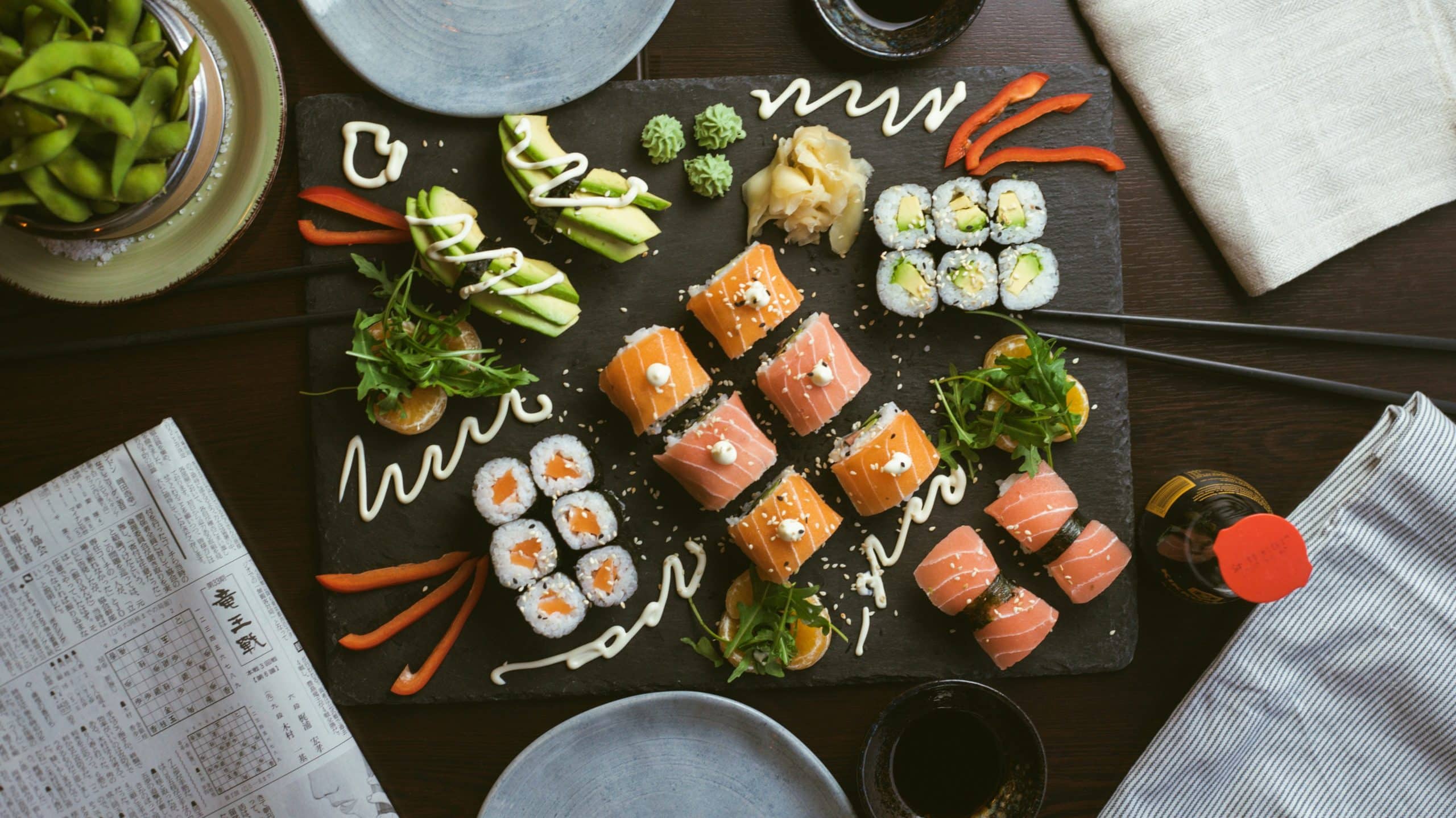Japanese cuisine beyond sushi

As food enthusiasts, you’ve more than likely had an encounter with sushi, the popular Japanese dish typically featuring rice seasoned with vinegar and an array of ingredients including seafood, vegetables, and sometimes tropical fruits. Yet, Japanese cuisine extends far beyond sushi. From mouthwatering tempura to flavorful ramen, Japan’s culinary scene offers an abundant variety of dishes that can make a food lover’s heart flutter. Packed with umami, Japanese food is about more than just flavors; it’s an art form, a tradition, and an integral part of the Japanese culture.
A Culinary Journey Through Tokyo’s Restaurants
Tokyo, Japan’s bustling capital, is home to over 160,000 restaurants, making it a city that has more restaurants per capita than any other city in the world. As a foodie, navigating Tokyo’s restaurant scene can be a thrilling yet overwhelming experience.
Lire également : The best fish and seafood recipes
As you explore Tokyo, you will come across a multitude of restaurants offering different Japanese dishes. However, understanding the menu can be tricky due to the language barrier. Hence, many restaurants now have an interface on their digital menus that you can easily navigate. Just a few taps on the screen, and your order is ready to be prepared.
One of the must-try dishes in Tokyo is Ramen. Unlike the instant variety most are familiar with, traditional Japanese ramen is a culinary masterpiece. It consists of Chinese-style wheat noodles served in a rich, meat-based broth, often flavored with soy or miso, and topped with ingredients such as sliced pork, spring onions, and nori seaweed.
A lire également : Discovering traditional European desserts
The Art of Tempura
Tempura is another signature Japanese dish that you shouldn’t miss. It’s a dish made of seafood and vegetables that have been battered and deep-fried. The sauce that accompanies tempura is usually a mix of dashi, mirin, and soy sauce. While it sounds simple, the technique of making Tempura is a fine art, requiring skillful chefs to ensure the batter is light, crispy, and not oily.
You can find Tempura at many restaurants in Tokyo, but for the best experience, it’s worth seeking out specialized Tempura restaurants. These establishments dedicate their service to perfecting the art of Tempura, offering an array of options from shrimp to sweet potato.
The Vegan Side of Japanese Cuisine
While Japanese cuisine is known for its seafood, there’s a growing trend of vegan and vegetarian-friendly restaurants in major cities such as Tokyo and Kyoto. The increasing demand for plant-based options has seen the rise of restaurants offering vegan versions of traditional Japanese dishes.
These restaurants often rely heavily on tofu, seitan, and a myriad of vegetables to create dishes that are just as flavorful and satisfying as their meat-based counterparts. From vegan sushi rolls to vegetarian ramen, these establishments offer a unique take on Japanese cuisine that’s not to be missed.
The Role of Reviews in Choosing the Right Restaurant
With the vast array of restaurants available in a city like Tokyo, having some guidance can be very useful. That’s where reviews come into play. Reading reviews of restaurants can help you get a sense of the restaurant’s service, the quality of their food, and the overall dining experience.
Many review platforms provide an interface featuring photos of the food, helping you visualize what to expect. Reviews are a valuable resource, especially when visiting a city as filled with culinary delights as Tokyo.
The Fusion of Japanese Cuisine and New York City
The influence of Japanese cuisine stretches far beyond the boundaries of Japan. In cities around the world, the love for Japanese food is evident. New York City, in particular, is known for its diverse food scene, and Japanese cuisine has found a prominent place there.
From high-end Japanese restaurants to causal ramen shops, you’ll find a spectrum of Japanese cuisine in New York. These establishments often fuse traditional Japanese cooking techniques with local ingredients, creating a unique dining experience.
Whether you are loading up on sushi at a conveyor belt restaurant, savoring the subtlety of a Kaiseki menu at a high-end establishment, or warming up with a bowl of ramen at a street-side stall, experiencing Japanese cuisine is a delightful journey. It’s not just about the food; it’s about the culture, the tradition, the passion that goes into every dish. As you journey through the world of Japanese cuisine, you’ll discover it’s a journey that goes far beyond sushi.
Gluten-Free Options in Japanese Cuisine
While most Japanese dishes traditionally contain gluten, the current trend towards healthier eating and dietary awareness has led many Japanese restaurants to provide gluten-free options. The menu of such restaurants now goes beyond sushi to include a wide array of gluten-free Japanese food.
For instance, there’s the option of gluten-free soy sauce – a staple in Japanese cuisine – available in most restaurants. Another gluten-free dish is the Shabu Shabu, a hotpot dish of thinly sliced meat and vegetables boiled in water. It’s served with dipping sauces, and the ingredients can be customized to adhere to a gluten-free diet.
Dumplings are another popular Japanese dish, and there are now gluten-free versions available. While traditionally made with wheat-based wrappers, many restaurants now offer dumplings made with rice wrappers. A look at dumplings photos from such eateries will reveal no difference in appearance, but the taste and texture offer a unique twist to the traditional dish.
A helpful review can guide you to restaurants serving gluten-free Japanese food, and photos reviews can offer a visual idea of what to expect. As a result, even those with dietary restrictions can enjoy a delightful journey through Japanese cuisine.
The Influence of Japanese Cuisine in the United States
Japanese cuisine has not only been embraced by the United States but has also been adapted to cater to the American palate. There’s a growing number of Japanese restaurants across the United States, serving both traditional and fusion dishes.
In major cities like New York, Japanese restaurants have become a staple in the food scene. Times Square, for instance, boasts a variety of Japanese restaurants offering a broad spectrum of dishes from sushi to ramen, Tempura, and more.
A popular trend in the United States is the fusion of Japanese and American flavors. An example of this is the sushi roll. Traditional sushi rolls usually feature raw fish and vegetables, but Americanized versions may include ingredients like cream cheese or avocado. Some restaurants even offer vegan sushi alternatives, using ingredients like shiitake mushrooms, black rice, and butternut squash.
Japanese fusion cuisine extends to desserts as well. Mochi ice cream is a popular dessert that combines traditional Japanese mochi (rice cake) with various flavors of ice cream. The end product is a delightful treat that is both familiar and exotic.
Conclusion: The World Beyond Sushi
As we delve deeper into Japanese cuisine, we discover that it is about more than just sushi. It’s about an array of dishes, each with its unique flavors and preparation methods. It’s about the culture, the tradition, the art that goes into each dish. It is a culinary journey that is rich, diverse, and colorful.
Japanese cuisine has made its mark worldwide, from Tokyo’s bustling restaurant scene to the fusion dishes in New York City. Across the globe, the influence of Japanese cuisine is evident and continues to grow.
So the next time you think of Japanese food, remember it’s not just sushi. There’s a whole world of flavors waiting to be explored. Whether you’re seeking a traditional experience, a fusion dish, a vegan meal, or a gluten-free option, Japanese cuisine has something to offer. So why not embark on a culinary journey beyond sushi? You might be surprised by the great food that awaits.
